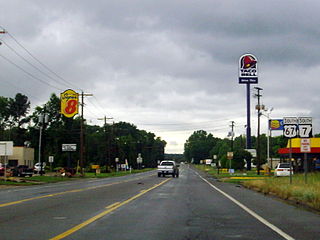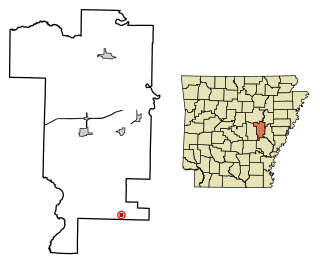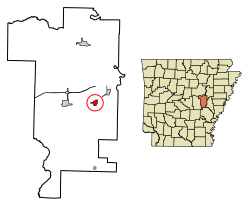
Prairie County is in the Central Arkansas region of the U.S. state of Arkansas. The county is named for the Grand Prairie, a subregion of the Arkansas Delta known for rice cultivation and aquaculture that runs through the county. Created as Arkansas's 54th county in 1846, Prairie County is home to four incorporated towns, including DeValls Bluff, the southern district county seat, and two incorporated cities, including Des Arc, the northern district county seat. The county is also the site of numerous unincorporated communities and ghost towns. Occupying 676 square miles (175,000 ha), Prairie County is the median-sized county in Arkansas. As of the 2020 Census, the county's population was 8,282. Based on population, the county is the ninth-smallest county of the 75 in Arkansas.

Almyra is a town in Arkansas County, Arkansas, United States. The population was 283 at the 2010 census.

St. Charles is a town in Arkansas County, Arkansas, United States. The population was 230 at the 2010 census. The small town has been at the center of various events in Arkansas' history. St. Charles is best known for the Battle of Saint Charles, which was fought on the White River, which borders the town. St. Charles is also known for being in the White River National Wildlife Refuge.

Big Flat is a town in Baxter and Searcy counties in the U.S. state of Arkansas. The population was 88 at the 2020 census.

Caddo Valley is a town in Clark County, Arkansas, United States. The population was 635 at the 2010 census.

Horseshoe Lake is a town in Crittenden County, Arkansas, United States. The population was 264 at the 2020 census.

Oil Trough is a town in Independence County, Arkansas, United States. The population was 260 at the 2010 census. The town is believed to have acquired its name in the early 19th century from a trough used to render bear fat, which was sold to customers in New Orleans.

Jacksonport is a town in Jackson County, Arkansas, United States, along the White River at its confluence with the Black River. The population was 212 at the 2010 census.

Sherrill is a town in Plum Bayou Township, Jefferson County, Arkansas, United States. Its population was 84 at the 2010 U.S. census. It is included in the Pine Bluff, Arkansas Metropolitan Statistical Area.

Minturn is a town in Lawrence County, Arkansas, United States. The population was 109 at the 2010 census.

Smithville is a town in Lawrence County, Arkansas, United States. The population was 78 at the 2010 census.

Morrison Bluff is a town in Logan County, Arkansas, United States. The population was 64 at the 2010 census and an estimated 81 in 2017.

Allport is a town in Lonoke County, Arkansas, United States. Although a black enclave in the largely-white Lonoke County since the 1870s, the town did not incorporate until 1967 in order to receive funding for municipal services. Located within Central Arkansas along Highway 165, the community's economy is strongly tied to agriculture. The population was 115 at the 2010 Census.

Roe is a town in Monroe County, Arkansas, United States. Located at the junction of U.S. Route 79 and Arkansas Highway 33, the population was 68 at the 2020 census, down from 114 in 2010.

Oden is a town in Montgomery County, Arkansas, United States. As of the 2020 census, its population was 180, down from 232 in 2010.

Des ArcDEZ-ark is a city on the White River in the Arkansas Delta, United States. It is the largest city in Prairie County, Arkansas, and the county seat for the county's northern district. Incorporated in 1854, Des Arc's position on the river has shaped its culture, history, and economy, beginning as a major lumber shipping port but leaving the city vulnerable to major floods in 1927 and 1937. As river shipping declined, Des Arc was bypassed by railroads, Interstate highways, and much of the post-industrial society. Des Arc's history is preserved by seven listings on the National Register of Historic Places, and the region's history is interpreted at Lower White River Museum State Park. The city's population stopped growing in the 1980s and has been declining since, with a population of 1,717 at the 2010 Census.

Fredonia (Biscoe) is a city in Prairie County, Arkansas, United States. The population was 363 at the 2010 census.

Hazen is a city in Prairie County, Arkansas, United States. The population was 1,481 at the 2020 census.

Ulm is a town in Prairie County, Arkansas, United States. The population was 205 at the 2000 census.

Patterson is a city in Woodruff County, Arkansas, United States. The population was 452 at the 2010 census.























